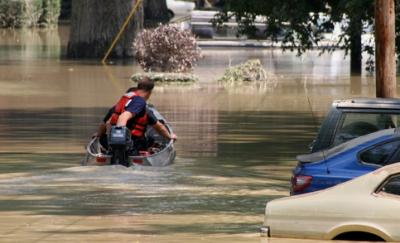How to Tackle Contaminants and Make Drinking Water Safer


Lead. PFAS. Perchlorate.
Drinking water has numerous contaminants like these and more than 140 unregulated chemicals. The risk to consumers from some of these chemicals is clear but for many it’s not. That’s because researchers haven’t figured out the threshold for when they cause harm.
As the government has grappled with what to do about them, Abt Global has been there to help. We have managed, supported, and provided technical assistance to the Environmental Protection Agency (EPA) for more than 40 years in a variety of areas. We have helped EPA’s efforts to ensure that lead pipes are identified and removed everywhere from cities to tribal organizations. We supported the Centers for Disease Control and Prevention’s Agency for Toxic Substances and Disease Registry (ATSDR) in its response to per- and polyfluoroalkyl substances (PFAS) contamination. And we’re providing EPA with regulatory development support for perchlorate, a contaminant used in rocket fuel and missiles.
Drinking water touches millions of homes, schools, and businesses across the country. As part of our decades of scientific partnership, we have helped EPA’s Office of Water and Office of Research and Development safeguard the nation’s health and economic well-being. Our work spans every phase of the process, from assessing the health effects of contaminants to evaluating treatment technologies’ effectiveness. And we developed the SafeWater CBX computer model to estimate both costs and benefits of drinking-water standards.
Community Engagement to Address PFAS Exposures
As always, the first step is data collection. For PFAS, Abt supported ATSDR in gathering data to support epidemiologic analyses. We used secondary datasets such as cancer registry records to assess the frequency of cases and deaths of potentially PFAS-related health outcomes. We then compared two kinds of communities: some that were exposed to PFAS-contaminated drinking water and some that weren’t.
To determine exposed communities, Abt biostatisticians analyzed PFAS concentration data from EPA’s third Unregulated Contaminant Monitoring Rule and population data from EPA’s Drinking Water Information System. In addition, our epidemiologists and data scientists analyzed health outcomes data to identify and compare rates of selected adverse health outcomes using ZIP codes and PFAS exposure categories.
“Our multidisciplinary teams are critical to providing the innovative and comprehensive studies our clients need,” says Environmental Policy and Regulatory Associate Emma Glidden-Lyon.
Gathering community exposure data requires community cooperation. One way to accomplish that is through community information sessions and social media ad campaigns. Abt’s ad campaign produced nearly two million impressions (number of times the ads were seen) and nearly 2,500 link clicks in eight geotargeted communities.
Tailoring information also is important. That can include site-specific results that take into account varying levels of awareness, concern, and community knowledge.


Science to Advance Water Treatment Technology
As the EPA has moved forward with updating regulations for emerging contaminants, Abt has supported the Agency’s Office of Water in evaluating drinking water treatment technologies. We have developed national technologies and costs analyses, analyses for best available technologies designation, and analyses of affordability of small system compliance for carcinogenic volatile organic compounds, fluoride, and perchlorate.
For each technology, we provided everything from detailed cost estimates and assessments of effectiveness for the target contaminant to pre- and post-treatment requirements, history of full-scale operation, and geographic applicability.
“Any practical program for treating contaminants requires accurate cost estimates for the full treatment lifecycle and an understanding of what you get for the money: the treatment’s effectiveness,” says Environmental Science Senior Associate Pat Ransom . “The EPA is required to consider costs and benefits, but that’s also how to build political support for the spending.”
Abt is updating the analyses for perchlorate by incorporating recent findings from scientific literature on technology effectiveness and the latest unit costs from treatment technology vendors. Abt has reviewed the scientific and engineering literature to add data to the Drinking Water Treatability Database for other emerging contaminants, including 1,4-dioxane, anatoxin. arsenic, cis- and trans-1,2-dichloethylene, cyanide, cylindrospermopsin, lithium, and microcystins. We also expanded the database’s coverage from two PFAS compounds in 2015 to 69 PFAS compounds today.
Drinking Water Treatment Costs, Benefits & Analysis
Most recently, Abt has supported all aspects of the EPA’s rulemaking issued in April 2024 to protect 100 million people from PFAS in drinking water, saving lives and preventing illnesses. Abt was instrumental in the development of the economic analyses for the proposed and final rules, including leading the development of national compliance cost estimates and comparing these estimates to projected public health benefits. We also analyzed treatment effectiveness and affordability required to designate processes as best available technologies and small system compliance technologies.
For the proposed PFAS rule, Abt conducted a national spatial analysis of environmental justice (EJ) to help EPA understand EJ implications of the rule and consider how to improve outcomes within disadvantaged communities. To assist with implementation of the final rule, we are developing an online decision support tool to enable users to compare the effectiveness and cost of different technologies, tailored to their unique system characteristics and requirements.
The breadth of Abt’s experience with every phase of drinking water regulation enables us to bring our suite of capabilities to help devise tailored solutions for different contexts. The SafeWater CBX computer model, for example, can assess different combinations of maximum contaminant levels (MCLs) and other model parameters. It can estimate benefit-cost ratios and economic impacts for different contaminants. The model also can simultaneously consider two or more user-specified MCLs for easy comparisons. Its flexibility is critical because populations, exposure levels, environmental factors, and budget constraints, among other factors, vary from community to community.
Read More

The 29th Conference of the Parties to the United Nations Framework Convention on Climate Change (COP29)
Abt will join governments, the private sector, and civil society at the 29th Conference of the Parties to the United Nations Framework Convention on Climate Change (COP29) this November to accelerate climate action.

Spotlight On: Climate Finance
Abt Global can help public-and private-sector actors take decisive action to finance equitable climate mitigation and adaptation strategies.

Nature Can Be a Solution to Climate Adaptation
Several years ago, my family took in a young man and his elderly mother after a flood destroyed their home.Eleven inches of rain had fallen in two days on tiny Painesville, Ohio, a community of 20,000 not far from Lake Erie. The Grand River had swollen to nine times its size and spilled into a row of low-income condominiums. Floodwater pushed past first-floor ceilings, in some cases rising to 17 feet.

2024 Federal Committee on Statistical Methodology (FCSM) Conference
Abt Global is exhibiting and presenting at 2024 Federal Committee on Statistical Methodology (FCSM) Conference.

Sixteenth Meeting of the Conference of the Parties to the Convention of Biological Diversity (COP16)


